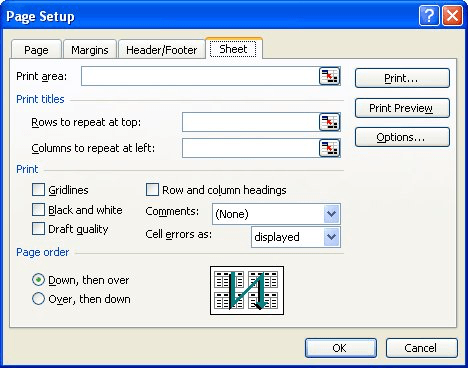Please Note: This article is written for users of the following Microsoft Excel versions: 2002 and 2003. If you are using a later version (Excel 2007 or later), this tip may not work for you. For a version of this tip written specifically for later versions of Excel, click here: Hiding Errors on Printouts.
Excel has a number of different errors that can appear in your worksheet, for any number of reasons. Errors values show up with a pound (hash) symbol followed by the type of error, as in #DIV/0! or #N/A.
When you print your worksheet, Excel prints the error values, by default. If you prefer, you can choose to have Excel not print the error values. Follow these steps:

Figure 1. The Sheet tab of the Page Setup dialog box.
In step 3, you have several options in the drop-down list:
ExcelTips is your source for cost-effective Microsoft Excel training. This tip (2989) applies to Microsoft Excel 2002 and 2003. You can find a version of this tip for the ribbon interface of Excel (Excel 2007 and later) here: Hiding Errors on Printouts.

Dive Deep into Macros! Make Excel do things you thought were impossible, discover techniques you won't find anywhere else, and create powerful automated reports. Bill Jelen and Tracy Syrstad help you instantly visualize information to make it actionable. You’ll find step-by-step instructions, real-world case studies, and 50 workbooks packed with examples and solutions. Check out Microsoft Excel 2019 VBA and Macros today!
Would you like to have a worksheet automatically printed when a particular cell contains a specified value? You can ...
Discover MoreNeed to print an entire workbook? It's as easy as adding a single line of code to your macros.
Discover MoreIf you want to save paper on a printout, you might consider printing multiple pages on a single piece of paper. This can ...
Discover MoreFREE SERVICE: Get tips like this every week in ExcelTips, a free productivity newsletter. Enter your address and click "Subscribe."
There are currently no comments for this tip. (Be the first to leave your comment—just use the simple form above!)
Got a version of Excel that uses the menu interface (Excel 97, Excel 2000, Excel 2002, or Excel 2003)? This site is for you! If you use a later version of Excel, visit our ExcelTips site focusing on the ribbon interface.
FREE SERVICE: Get tips like this every week in ExcelTips, a free productivity newsletter. Enter your address and click "Subscribe."
Copyright © 2025 Sharon Parq Associates, Inc.
Comments